
Corymbia ficifolia, commonly known as the red flowering gum, Albany red flowering gum and the Albany redgum, is one of the most commonly planted ornamental trees in the broader eucalyptus family. The species was previously known as Eucalyptus ficifolia until re-classified in 1995.
Gum tree is a common name for smooth-barked trees and shrubs in three closely related genera of Eucalypt:

Angophora is a genus of flowering plants in the myrtle family, Myrtaceae, described as a genus in 1797. It is endemic to Australia, where species are distributed in Queensland, New South Wales, and Victoria. The centre of diversity is along the northern and central coast of New South Wales.
Red gum or redgum may refer to:

Northbourne Avenue is a major road in Canberra, Australia. It extends from City Hill in the south to the Federal Highway in the north. Its northern end is at the intersection with Antill and Mouat streets, but it is often considered to extend over the southern end of the Federal Highway to the intersection with the Barton Highway.

Eucalyptus punctata, commonly known as grey gum, is a large tree of the myrtle family, Myrtaceae, native to South East Queensland and eastern New South Wales, where it specialises in poor soils such as Sydney sandstone. Its leaves are one of the favoured foods of the koala. The tree's common name comes from its bark, which takes a greyish cast at about one year of age. On most trees this bark is partly shed, revealing a bare and slightly orange or brown tinted smooth surface. The white flowers appear over the summer.

Corymbia calophylla is a species of tree, common in the southwest of Australia. Originally described as a species of Eucalyptus, it is commonly named as marri in preference to red gum.

Corymbia terminalis, also known as tjuta, joolta, bloodwood, desert bloodwood, plains bloodwood, northern bloodwood, western bloodwood or the inland bloodwood, is a tree native to Australia.

Henicopsaltria eydouxii, commonly known as the razor grinder, is a large species of cicada native to eastern Australia. Predominantly brown in colour, it is found in dry and wet sclerophyll forest in December and January and is quite common in Brisbane.
Corymbia abbreviata, also known as the scraggy bloodwood, is a bloodwood native to Western Australia and the Northern Territory.

Corymbia erythrophloia, commonly known as the variable-barked bloodwood, the red-barked bloodwood, the gum-topped bloodwood or the red bloodwood, is a bloodwood native to Queensland, Australia.

Corymbia foelscheana, commonly known as the fan-leaved bloodwood, smooth-barked bloodwood or the broad-leaved bloodwood, is a bloodwood native to the Northern Territory and Western Australia.
Corymbia jacobsiana, commonly known as Jacob's bloodwood or the stringybark bloodwood, is a member of the genus Corymbia native to Australia's Northern Territory

Corymbia setosa, commonly known as the rough leaved bloodwood and the rough leaved range gum, is a member of the genus Corymbia native to northern Australia.

The Cumberland Plain Woodland is one of six main indigenous forest communities of Sydney, New South Wales, Australia. Situated in the Cumberland Plain, it is made up of dry sclerophyll woodlands and forests, reminiscent of the Mediterranean forests. Currently, less than 6% of the Woodlands remain in small parts distributed across the western suburbs of Sydney, totaling only around 6400 hectares.
This page is based on this
Wikipedia article Text is available under the
CC BY-SA 4.0 license; additional terms may apply.
Images, videos and audio are available under their respective licenses.













